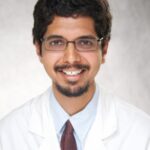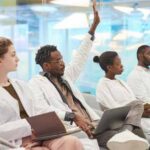 During the height of the pandemic four years ago, I took every precaution to avoid, or at the very least, delay contracting COVID-19. I religiously wore a mask in all public settings, I washed my hands so frequently that my skin became dry and cracked, and I studiously maintained a six-foot distance from others. But one measure I did not take was avoiding handshakes in the clinic.
During the height of the pandemic four years ago, I took every precaution to avoid, or at the very least, delay contracting COVID-19. I religiously wore a mask in all public settings, I washed my hands so frequently that my skin became dry and cracked, and I studiously maintained a six-foot distance from others. But one measure I did not take was avoiding handshakes in the clinic.
During a pandemic in which this was particularly frowned upon in favor of waves and other no-touch greetings, this may seem like a curious gesture to be so adamant about.1 However, I contend that a firm exploratory handshake gets to the root of what it means to be an excellent clinical rheumatologist. And that’s only the beginning.
The musculoskeletal physical examination, which includes careful observation of the hands through everyday gestures like handshakes, is part of an enduring legacy from generations of clinicians. So what role does the clinical exam play today, and how will it change in the future? Let’s rheuminate!
The Human Touch
First and foremost, there is something innate and magical about the human touch. One of the five senses, touch is particularly resonant, especially when it comes to establishing trust. Being open to engaging in touch and being examined is a sign of mutual respect and connection.2 It is also a profound means of communication on a nonverbal level—the subtleties of how a finger lands on a joint can express volumes of our intentions to understand another person’s condition and health.3
Additionally, years of research have established the neuropsychological effects of touch, including increased levels of dopamine and serotonin, neurotransmitters that regulate mood and reduce anxiety.4 It is no coincidence that good doctors are often spoken about as having the magic touch. In that respect, the physical examination is more than just a diagnostic tool, but also an important element of the healing process.5
The physical examination is also largely a part of the expectation that patients experience when they come to the rheumatologist’s office.6 Through prior experiences, popular culture and social media, patients have come to believe that a visit is only complete once a physician takes a look, touches and listens to their body. Although that obviously has changed somewhat with the pandemic, the advent of telemedicine and trends toward shorter clinic times that lead to abbreviated examinations, the physical examination is still very much a part of what we do and how we build relationships with our patients.
Opportunities to Show We Care
Unfortunately, a lot of the physical examination has been sterilized into a set of diagnostic procedures. In particular, the Journal of the American Medical Association (JAMA) published a series about the rational clinical examination, which discussed physical examination maneuvers as diagnostic tests.7 Not surprisingly, most of the maneuvers did not have characteristics specific or sensitive enough for deployment in diagnostic settings. Yet this misses the point.
When I shake a patient’s hand, I am not looking to establish the diagnosis of rheumatoid arthritis or psoriatic arthritis. What I am looking for are the subtle, barely noticeable signs of human disease and well-being. How firm is the patient’s grip? Is there even the slightest grimace on their face? Can I feel the contours of hypermobility? Do the fingers align roughly well, or are there signs of deformity? What stiffness is detectable at the wrist or even shoulder level? Are hints of systemic disease visible in their fingernails? While it would be nice to know the receiving characteristics of a standardized handshake, I doubt there is any good experimental design to detect the effectiveness of a handshake for physical examination purposes.
I don’t keep these observations to myself. In an age that prioritizes equity and inclusivity, I make sure to inform patients that this handshake is more than just a formality. I tell them, usually a little afterward, exactly what I felt and saw when I shook their hands. It’s a sign of appreciation for their time that I am prioritizing every opportunity to understand who they are. At the same time, it draws out stories and narratives that might otherwise be missing. For example, a tattoo on the finger can tell volumes about a patient’s values, or a sole fingernail painted black can lead to a very personal story the patient is waiting to tell you.
Priming the Examination
Of course in and of itself, a handshake is insufficient for a regional musculoskeletal physical examination. But it is an important initial step. I usually use the data from the handshake to gauge how to later approach the more systemic finger-by-finger, joint-by-joint examination. If the handshake was very delicate, I make sure my touch is gentler than usual so as not to elicit as much pain. If the handshake was more vigorous, I take greater effort to find more subtle signs of swelling and tenderness.
And just like with the hand physical examination and a good old-fashioned handshake, I make sure to look at the patient’s eyes and examine the facial expressions, as well. Complex emotions, such as excitement, fear, anxiousness, distress and resentment, may show up in the face early in the appointment. These cues can guide history taking and physical examination, making them much more appropriate and nuanced.
The handshake is also a large part of how I avoid getting stuck to the computer screen. It’s no secret that clinicians interface with their computer screens significantly during outpatient encounters.8 Nobody can blame physicians for doing so, but there are downsides of such inattention to the patient. A simple handshake and a look in the eye can really prime the encounter so the whole time feels a little bit more patient centered.
Not Just Handshakes
The handshake is only one of the many elements of the physical examination that are often overlooked. Because observation is at the heart of the physical examination, and, according to many experts, is the most critical element of the physical examination, it is important for clinicians to be deeply immersed in our patient encounters for the purposes of the physical examination.9 The dermatologic examination (of exposed areas) and neurologic examination (for speech, symmetry and coordination, among others) are good examples of where deep inspection can happen seamlessly during a patient visit without much extra time added.
Much like how a handshake can initiate and prime the clinical encounter, accompaniment of the patient to the front desk can be a great way to end an encounter. By carefully observing a patient’s ability to get up from a seated position and inspecting their gait, a clinician can get a holistic understanding of the sense of their musculoskeletal function. At the same time, by literally joining with the patient throughout the encounter, clinicians can demonstrate a commitment to their well-being without adding much time to the encounter.
In fact, while we tend to split history taking and the physical examination into binary opposites—one that we solicit and the other that we elicit—a comprehensive physical examination unites the mind and the body. The physical exam, when conducted properly, can complement what is stated in the history and vice versa. When documented accurately, the physical exam can also be a vivid and unique reminder of the patient’s burden of disease and manifestations of illness.
The Future of the Physical Exam
There are many reasons why the physical examination seems to have become less prominent in healthcare. To many, the physical exam is inexact, imprecise or outdated. Much of the support behind the physical exam appears to be received wisdom that contradicts our modern paradigm of evidence-based practice. Making matters worse is that the greatest evangelists for the physical examination tend to also be on the more senior side. Appeals to reinstate the physical examination are often heavy-handed, with a “kids these days!” subtext. Given all these factors, it seems like the physical exam is a thing of the past, unable to compete with the highly precise laboratory and radiographic studies that we now rely upon.
The truth is the contrary: The physical examination endures and evolves with the times. It accommodates scientific and technological advances, if we give it an opportunity to do so. Already, cardiologists utilize digital stethoscopes to better pick up the sounds of murmurs, gallops and rubs.10 In rheumatology, point-of-care musculoskeletal ultrasonography is arguably more an extension of the physical exam than a radiographic study.11 And of course, many of the disease activity scores that we use for treat-to-target strategies employ the physical examination as part of the criteria.
I am eager to see how large datasets redefine our diseases based on phenotypes. Correlation of radiographic, serologic and genetic data with physical manifestations of disease may lead to clinical insights that will be invaluable for upholding well-being. Artificial intelligence, either in the detection of physical exam signs or the interpretation of the physical examination, may also be a way to bring a longstanding tradition into the 21st century and beyond.
Intriguingly, the advent of telerheumatology brings with it great opportunities to reconsider what it means to do the physical exam without touch.12 Although I remain skeptical about whether the telerheumatology physical examination can ever replace the in-person physical examination, there are great advantages of telemedicine with respect to the physical exam. Crucially, the ability to observe a patient in their home environment is something the in-person physical exam simply cannot deliver.
Who’s Examining Whom?
There is one last reason that I strongly advocate for the musculoskeletal physical examination, and oddly enough, it has little to do with the patient. The musculoskeletal physical exam is good for the soul for the clinician. Clinicians in the U.S. are stuck in a dystopian world with prior authorizations, Press-Ganey scores, RVU targets, inbox messages, maintenance of certification and a million other things that seem to degrade the worth of our profession. All these things make it hard to remember why we entered this profoundly special field that emphasizes humanism and feeling.
The physical examination is a potent antidote. Taking time and effort with the patient to understand their condition through the close art of observation is therapeutic for the clinician’s soul. Feeling a patient’s joints time after time and knowing they are no longer as swollen or tender is an extremely satisfying experience. Knowing patients better by understanding the stories of their tattoos personalizes an experience that our faceless healthcare sector simply does not prioritize because it cannot be turned into a metric.
In short, although clinicians believe they are examining patients, a strange process is simultaneously occurring on the other side: Patients are examining their clinicians.13 Patients are listening to their clinicians, listening to their hearts and asking whether they can be trusted. Patients are feeling the warm touch of a clinician’s fingertips lingering over their interphalangeal joints. On a deep level, patients are assessing whether their clinicians are sincerely conducting the physical exam or merely performing them.
The physical exam is something that has been both praised and condemned, often in the same breath. It’s been lauded as a mythical panacea to the many ails of our healthcare system and, as a result, been seen as a letdown when it doesn’t meet those expectations. As I rheuminate on the physical exam, I see it as something else. I see the physical exam as the core, the very pith, of clinical rheumatology, upon which all our other efforts rest.
The physical exam is, ultimately, what both clinicians and patients make it out to be. If we imbue it with meaning, purpose and sincerity, then we can use it as a tool to ensure the world of rheumatology is more humanistic and remains true to its goal of maintaining the healing touch.
 Bharat Kumar, MD, MME, FACP, FAAAAI, RhMSUS, is the director of the rheumatology fellowship training program at the University of Iowa, Iowa City, and the physician editor of The Rheumatologist. Follow him on X @BharatKumarMD.
Bharat Kumar, MD, MME, FACP, FAAAAI, RhMSUS, is the director of the rheumatology fellowship training program at the University of Iowa, Iowa City, and the physician editor of The Rheumatologist. Follow him on X @BharatKumarMD.
References
- Oaklander M. The Coronavirus killed the handshake and the hug. What will replace them? Time. 2020 May 27. https://time.com/5842469/corona-virus-handshake-social-touch.
- Heatley Tejada A, Dunbar RIM, Montero M. Physical contact and loneliness: Being touched reduces perceptions of loneliness. Adapt Human Behav Physiol. 2020;6(3):292–306.
- Bjorbækmo WS, Mengshoel AM. ‘A touch of physiotherapy’—the significance and meaning of touch in the practice of physiotherapy. Physiother Theory Pract. 2016;32(1):10–19.
- Eckstein M, Mamaev I, Ditzen B, Sailer U. Calming effects of touch in human, animal, and robotic interaction—scientific state-of-the-art and technical advances. Front Psychiatry. 2020 Nov 4;11:555058.
- Leder D, Krucoff MW. The touch that heals: The uses and meanings of touch in the clinical encounter. J Altern Complement Med. 2008 Apr;14(3):321–327.
- Hashim MM, Edgeworth DM, Saunders JA, Harmon DC. Patient’s perceptions of physical examination in the setting of chronic pain. Ir J Med Sci. 2021 Feb;190(1):313–316.
- Sackett DL. The rational clinical examination. A primer on the precision and accuracy of the clinical examination. JAMA. 1992 May 20;267(19):2638–2644.
- Kazmi Z. Effects of exam room EHR use on doctor-patient communication: A systematic literature review. Inform Prim Care. 2013;21(1):30–39.
- Elder AT, McManus IC, Patrick A, et al. The value of the physical examination in clinical practice: An international survey. Clin Med (Lond). 2017 Dec;17(6):490–498.
- Silverman B, Balk M. Digital stethoscope-improved auscultation at the bedside. Am J Cardiol. 2019 Mar 15;123(6):984–985.
- Jackson SS, Le HM, Kerkhof DL, Corrado GD. Point-of-care ultrasound, the new musculoskeletal physical examination. Curr Sports Med Rep. 2021 Feb 1;20(2):109–112.
- Lee PS, Koo S, Panter S. The value of physical examination in the era of telemedicine. J R Coll Physicians Edinb. 2021 Mar;51(1):85–90.
- Rose G, Segesten K. Someone who cares—patients’ experiences concerning health examinations. Scand J Caring Sci. 1995;9(2):105–112.


